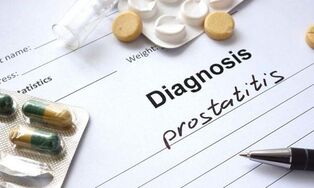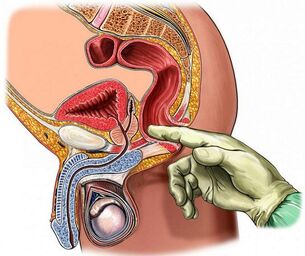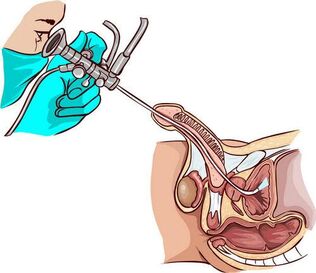
The more complete and efficient the diagnosis of prostatitis is, the more effective the next therapy will be. The doctor's formal approach can result in long-term and ineffective treatment for patients. Its job is to identify prostate inflammation and all the provoking factors.
How doctors diagnose prostatitis
Prostatitis is diagnosed by a urologist or andrologist. After talking with the patient, the doctor prescribes the necessary examination: first, a standard set (blood, urine, prostate secretion, rectal examination), then, if indicated, more detailed and high-tech methods are used: CT, MRI, ultrasound.
Taking anamnesis
During the initial consultation, the doctor will ask the following questions:
- Period of intercourse (if it becomes shorter, then under what circumstances);
- Presence of discomfort in the groin during prolonged in a static position, as well as after drinking alcohol or hypothermia;
- Frequency and speed of urination (do difficulties, intermittent jets, do you often have to get up to use the toilet at night);
- Quality of orgasm (still bright or blurred, pain in ejaculation).
The more detailed the patient remembers, the more complete the clinical picture made by the doctor.
Differential Diagnostics
Symptoms of prostatitis are similar to some other diseases:
- Cystitis (cramps during urination, pain in the lower abdomen).
- Adenoma (difficulty urinating, feeling of heaviness in the groin).
- Prostate cancer (blood in the urine, problems with urination).
- Rectal pathology: hemorrhoids, paraproctitis (inflammation), anal fissures, crepes (ulcerative colitis).
Additional diagnostic methods and reasons for their use are shown in Table 1.
Table 1. Differential diagnosis of prostatitis
| Disease | Risk group | Analyze |
|---|---|---|
| Hyperplasia | Men over the age of 45 who do not have a history of urethritis, catheterization, trauma to the bladder and urethra (conditions that may explain pain, blood in the urine) | Ultrasound and digital prostate examination |
| Prostatitis | Most young men have recently had a fever, hypothermia, in their history where there were no provoking factors (similar to hyperplasia) | ultrasound, complete blood count (CBC), digital prostate examination |
| Prostate cancer | Men over 45 years old, no history of provoking factors | Prostate ultrasound, PSA analysis, digital examination |
If necessary, other specialized doctors are involved in the diagnosis: proctologist, neurologist, vertebrologist. The last two experts identified the cause of pain associated with violations of spinal structure, violations of nerve endings.
Rectal palpation

Digital rectal examination is the most accessible and informative method of examining the condition of the prostate. During the procedure, the doctor observes the following structural parameters:
- Volume;
- Density;
- Surface roughness;
- Homogeneity (tissue homogeneity);
- Borders (outline clarity);
- Preservation of isthmus (longitudinal suture between lobes).
In prostatitis, the gland enlarges due to edema (asymmetry may be), the consistency is elastic, the longitudinal groove (suture) is not felt, and the patient may feel pain when touched.
For a clear picture of this type of diagnosisneedprepare:
- Do not ejaculate the day before, do not drink alcohol, avoid excessive physical exercise, hypothermia and overheating.
- Do not ride a bicycle for 24 hours, do not use a rowing machine (do not injure or massage the prostate this way).
- Before seeing a doctor, make an enema (micro enema can be used) to clean the rectal ampoule.
You can feel the prostate at a depth of 3-5 cm from the anus. The doctor performs the procedure with sterile gloves, lubricating the fingers with gel. The patient lies on the side with the knees tucked in or standing in the elbow position.
Laboratory Methods
Laboratory methods for diagnosing prostate inflammation involve biomaterial studies for the presence of pathogens.
Blood
Based on the results of general and biochemical blood tests (take capillaries from the fingers), prostatitis can be suspected at an early stage. Analysis was taken on an empty stomach in the morning. You should refrain from smoking an hour before the procedure.
Important hints:
- Leukocytes (blood cells, increased in number with decreased immunity against the background of inflammatory reactions). Usually from 4-9 × 10 ^ 9 units;
- ESR (erythrocyte deposition rate). Normally it is about 5 units, the increase indicates inflammation or oncological processes;
- Lymphocytes. Typically, the percentage of total blood cell volume ranges from 18 to 40 units. Excess means infection.
Men over 40 are given a PSA test- tumor markers, exceeding the value of chronic prostatitis or prostate cancer.Norma- less than 4 ng / ml, after 50 years - 5, 53 ng / ml.
Urine
The urethra passes through the prostate (the prostate portion of the urethra), so when the gland is inflamed, the urine changes color and consistency. For the diagnosis of prostatitis, three types of analysis are taken:
- General - determination of physical and chemical parameters. Signs of prostate inflammation: cloudy urine, vaginal discharge, alkali, protein, leukocytes, purulent threads, sometimes foam or blood. With calculus prostatitis, phosphate is found.
- Cytology - examination for the presence of pathologically altered cells. The presence of erythrocytes and epithelium may indicate a tumor process.
- Bacteriology - identifies traces of pathogen microorganism activity. To do this, make a tank sediment on the nutrient medium. If there are bacteria and fungi, then after a while they begin to actively reproduce. Escherichia coli often causes prostatitis.
Before urinating, you should not eat salty and spicy foods, do not drink alcohol and dye products (beets, coffee). Analysis was taken in the morning on an empty stomach.For prostatitis, a three-glass test method is used:the patient urinates alternately in each glass; the result is the first, middle and last parts. This method allows you to identify the localization of inflammation: urethra, prostate, bladder. The four-glass method is more informative. The last urine sample was collected after a prostate massage to get its secretion.
Secrets of prostate and sperm
Juice produced by the prostate gland is a valuable diagnostic material. Prepare the fence in the same way as for a digital examination of the rectum. In order to keep the amount of secrets, you should refrain from having sex for three to five days.
Methods for checking prostate secretions:
- Microscopy;
- Reproduction;
- PCR (polymerase chain reaction).
PCR is the most accurate method. For biomaterial processing, special enzymes are used that double the number of DNA fragments and pathogen RNA. This research requires a special tool - an amplifier. Real-time PCR. The results are ready in an hour.
Inflammation of the prostate is indicated by the presence of amyloid body juice, staphylococci, streptococci, Pseudomonas aeruginosa, epithelial cells (more than three units in the field of view). The number of lipoid grains decreases, and the number of leukocytes increases.
Spermogramfor prostatitis is an additional analysis. Against the background of prostate inflammation, sperm turn yellowish or brown, their viscosity increases (fluid over time), and pathogenic microflora is present. In chronic prostatitis, glandular epithelial cells, amyloid bodies and mucus are found.
Sweep the urethra

Urethral broom (scraping) is a less informative method of diagnosing prostatitis than secretion analysis.Used in cases where it is impossible to get the latter due to hemorrhoids, worsening swelling, presence of calcification in the prostate body.
Procedure for taking the material quickly, but uncomfortably: the doctor inserts a comb into the urethra, which catches part of the cell that closes it along with the microorganism. The biomaterial is then examined by PCR, which allows you to determine the presence of pathogens in any quantity. Causes of prostatitis can be genital infections: chlamydia, Trichomonas, mycoplasma.
Before performing the analysis for a day, you should refuse sexual intercourse, in the morning, just perform an external penis hygiene procedure (do not pour anything into the urethra), do not urinate for two hours.
Instrumental Methods
Instrumental diagnostic methods allow you to confirm and add laboratory test results.
Ultrasound and TRUS
Ultrasound examination of the prostate makes it possible to visualize its structure, its contours, the nature of tissue changes. In the case of prostatitis, transrectal ultrasound (TRUS) is considered the most informative: the doctor inserts a probe into the rectum. Prepare the procedure in the same way as palpation of the glands. Abdominal ultrasound (through the abdomen) is more comfortable for a man, but the prostate is not fully visible due to the bladder.
With inflammation of the prostate gland, the structure is heterogeneous, the contours are blurred, the focus is fibrosis (too much connective tissue), there are scars. The prostate enlarges, the groove between the lobes is launched.
MRI, PET and CT
If ultrasound gives reason to suspect the presence of a tumor process, the doctor prescribes CT (computed tomography) or MRI (magnetic resonance imaging) to clarify the image. The latter type of research is more accurate, but also more expensive. The procedure is painless, in terms of the content of the information, they can replace the biopsy (pinch of tissue fragments).
CT and MRI show in detail the structure of the prostate: stones, cysts, tumors, inflammatory foci, structural abnormalities. For a clearer picture, a contrast agent is injected into the initial vein (not used for men with renal failure). For the procedure, appropriate types of tomographs and rectal probes were used.
PET - Positron Emission CT. Allows you to analyze the condition of the prostate at the cellular and molecular level. This determines not only the presence and size of the tumor, but also the speed and quality of the metabolic processes that take place in it.
About preparation:the rectum should be emptied. Do not eat for five hours before the procedure.
Characteristics of the diagnosis of certain types of prostatitis
Acute (infectious) bacterial prostatitis is diagnosed based on patient complaints, urinalysis, ultrasound, urethral smear. With active inflammation, painful glands, transrectal interventions are not allowed, in extreme cases, careful examination of the fingers.
Laboratory data for the diagnosis of acute prostatitis are not very informative. Urine culture may be recommended, but not required. With active inflammation, there is no time to wait for the results. To relieve symptoms, antibacterial therapy with broad-spectrum drugs is performed.
Chronic prostatitis practically does not manifest itself in any way, therefore, its detection requires a variety of laboratory, physical, instrumental methods. Determination of the patient's immune and neurological status may be required.
Palpation, urination and prostate secretion are very important. The presence of more than 10 leukocytes in the field of view indicates inflammation. If the bacterial culture does not provide the growth of infectious microflora against the background of an increase in the number of leukocytes, then analysis is required for genital infections.
Due to the inflammatory properties of bacteria in urine and prostate juice, a large number of pathogens are found. An undisputed microbiological sign of chronic inflammation: the number of microbes (CFU) is more than 104 per ml. Some of them number in the tens, so their presence in the range of 10 to 102 per ml may indicate prostatitis.
In bacterial (non-infectious) inflammation, they are absent, but experts recommend in such cases to conduct a more in-depth analysis: prostate puncture, in which pathogens living in the closed prostate canal are extracted. At the same time, bacterial cultures are sterile, but pathogens are still found in the end. Often it is one type of E. coli.
Ultrasound does not always show chronic inflammation. In addition to the methods mentioned above, the doctor may prescribe uroflowmetry - a measurement of urine flow rate using a special sensor.
Special comorbidities

For long-term chronic prostatitis with signs of coliculitis (inflammation of the tubercle of semen near the prostate), urethroscopyis used - visual examination of the canal using an endoscope. Helps identify narrowing of the urethra, violations of its structure, the condition of the prostate excretory tract (mucus, pus, thickening) and seminal tubercle.
Interpretation of results (determination of the degree of prostatitis by the tubular condition of the semen):
- First: tubercle seeds red, edematous, bleeding. A similar pattern is observed in the posterior part of the urethra;
- Second: periodic increase in redness and swelling are characteristic;
- Third: cicatricial changes in tubercle and urethral tissues occur, as the ureter lumen may narrow (narrowing).
Ureteroscopy irritates the seminal tubinal receptors, which causes disruption of microcirculation and prostate movement, so this procedure should not be performed unnecessarily.
Cystitis is also a companion to chronic prostatitis. Inflammation of the bladder wall is detected by ultrasound andcystoscopy. During research, pathological changes in the mucous membranes are determined, especially in the neck area. Bladder condition with a background of chronic prostatitis (prostate sclerosis):
- Cicatricial defects of the bladder triangle.
- Ureter hole dilated.
- Neck tightening.
Cystoscopy is prescribed in the final stages of examination if there is pain in the lower abdomen and frequent urination.
The most difficult to diagnose is chronic abacterial prostatitis with unspecified pelvic pain. In such patients, the doctor first conducts research to exclude cystitis and neuropsychiatric pathology.
How to diagnose prostatitis at home
A man may suspect acute prostatitis with the following symptoms:
- Severe pain in lower abdomen and groin (between testicles and anus);
- Increased body temperature;
- Pain when urinating (such as cystitis);
- Early and painful ejaculation.
Similar symptoms appear during the exacerbation of chronic prostatitis, caused by hypothermia or alcohol intake. The development of this form of pathology can be evidenced by the periodic appearance of blood in the urine, dull pain in the perineum (especially in static conditions), difficulty urinating, worsening of erections. Such a sign is a reason to contact a urologist.
Conclusion
The longer the inflammatory process in the prostate lasts, the harder it is to treat, so you should not delay the diagnosis. In government institutions, most follow-up procedures and treatments are free.
























